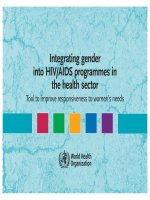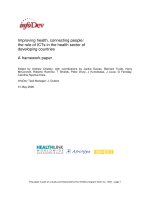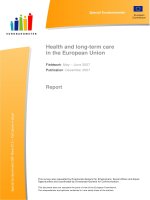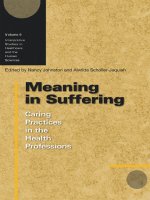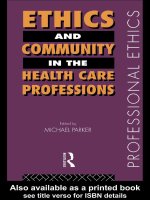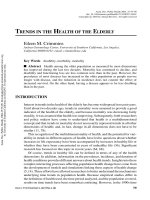REDESIGNING CONTINUING EDUCATION IN THE HEALTH PROFESSIONS pot
Bạn đang xem bản rút gọn của tài liệu. Xem và tải ngay bản đầy đủ của tài liệu tại đây (12.13 MB, 297 trang )
Committee on Planning a Continuing Health Care
Professional Education Institute
Board on Health Care Services
THE NATIONAL ACADEMIES PRESS
Washington, D.C.
www.nap.edu
REDESIGNING
CONTINUING EDUCATION
HEALTH PROFESSIONS
IN THE
THE NATIONAL ACADEMIES PRESS 500 Fifth Street, N.W. Washington, DC 20001
NOTICE: The project that is the subject of this report was approved by the Gov-
erning Board of the National Research Council, whose members are drawn from
the councils of the National Academy of Sciences, the National Academy of Engi-
neering, and the Institute of Medicine. The members of the committee responsible
for the report were chosen for their special competences and with regard for
appropriate balance.
This study was supported by Contract No. B08-03 between the National Academy
of Sciences and the Josiah Macy, Jr. Foundation. Any opinions, findings, conclu-
sions, or recommendations expressed in this publication are those of the author(s)
and do not necessarily reflect the view of the organizations or agencies that pro-
vided support for this project.
International Standard Book Number-13: 978-0-309-14078-2
International Standard Book Number-10: 0-309-14078-1
Additional copies of this report are available from the National Academies Press,
500 Fifth Street, N.W., Lockbox 285, Washington, DC 20055; (800) 624-6242 or (202)
334-3313 (in the Washington metropolitan area); Internet, .
For more information about the Institute of Medicine, visit the IOM home page
at: www.iom.edu.
Copyright 2010 by the National Academy of Sciences. All rights reserved.
Printed in the United States of America
The serpent has been a symbol of long life, healing, and knowledge among almost
all cultures and religions since the beginning of recorded history. The serpent
adopted as a logotype by the Institute of Medicine is a relief carving from ancient
Greece, now held by the Staatliche Museen in Berlin.
Suggested citation: IOM (Institute of Medicine). 2010. Redesigning Continuing Edu-
cation in the Health Professions. Washington, DC: The National Academies Press.
society of distinguished scholars engaged in scientific and engineering research,
dedicated to the furtherance of science and technology and to their use for the
general welfare. Upon the authority of the charter granted to it by the Congress
in 1863, the Academy has a mandate that requires it to advise the federal govern-
ment on scientific and technical matters. Dr. Ralph J. Cicerone is president of the
National Academy of Sciences.
The National Academy of Engineering was established in 1964, under the char-
ter of the National Academy of Sciences, as a parallel organization of outstand-
ing engineers. It is autonomous in its administration and in the selection of its
members, sharing with the National Academy of Sciences the responsibility for
advising the federal government. The National Academy of Engineering also
sponsors engineering programs aimed at meeting national needs, encourages
education and research, and recognizes the superior achievements of engineers.
Dr. Charles M. Vest is president of the National Academy of Engineering.
The Institute of Medicine was established in 1970 by the National Academy of
Sciences to secure the services of eminent members of appropriate professions
in the examination of policy matters pertaining to the health of the public. The
Institute acts under the responsibility given to the National Academy of Sciences
by its congressional charter to be an adviser to the federal government and, upon
its own initiative, to identify issues of medical care, research, and education.
Dr. Harvey V. Fineberg is president of the Institute of Medicine.
The National Research Council was organized by the National Academy of
Sciences in 1916 to associate the broad community of science and technology
with the Academy’s purposes of furthering knowledge and advising the federal
government. Functioning in accordance with general policies determined by the
Academy, the Council has become the principal operating agency of both the
National Academy of Sciences and the National Academy of Engineering in pro-
viding services to the government, the public, and the scientific and engineering
communities. The Council is administered jointly by both Academies and the
Institute of Medicine. Dr. Ralph J. Cicerone and Dr. Charles M. Vest are chair and
vice chair, respectively, of the National Research Council.
www.national-academies.org
v
COMMITTEE ON PLANNING A CONTINUING HEALTH CARE
PROFESSIONAL EDUCATION INSTITUTE
GAIL L. WARDEN (Chair), President Emeritus, Henry Ford Health
System and Professor of Health Management and Policy at the
University of Michigan, School of Public Health, Detroit
JAKO S. BURGERS, Harkness Fellow 2008-2009, Harvard School
of Public Health, Boston, Massachusetts, and Senior Researcher,
Scientific Institute for Quality of Healthcare (IQ healthcare),
Radboud University Nijmegen Medical Centre, The Netherlands
LINDA BURNES BOLTON, Vice President and Chief Nursing Officer,
Cedars-Sinai Medical Center, Los Angeles, California
CATHERINE DeANGELIS, Editor-in-Chief and Senior Vice President,
Scientific Publications and Multimedia Applications, JAMA,
Chicago, Illinois, and Professor, Johns Hopkins University, School of
Medicine, Baltimore, Maryland
ROBERT D. FOX, Professor Emeritus of Adult and Higher Education,
University of Oklahoma, Norman
SHERRY A. GLIED, Professor and Chair, Department of Health Policy
and Management, Columbia University, Mailman School of Public
Health, New York
KENDALL HO, Director, eHealth Strategy Office, Associate Professor,
Division of Emergency Medicine, Faculty of Medicine, University of
British Columbia, Vancouver
EDWARD F. LAWLOR, Dean and William E. Gordon Distinguished
Professor, George Warren Brown School of Social Work at
Washington University in St. Louis, Missouri
DAVID C. LEACH, Former Executive Director, Accreditation Council
for Graduate Medical Education, Asheville, North Carolina
LUCINDA MAINE, Executive Vice President and Chief Executive Officer
(CEO), American Association of Colleges of Pharmacy, Alexandria,
Virginia
PAUL E. MAZMANIAN, Associate Dean for Continuing Professional
Development and Evaluation Studies, School of Medicine, Virginia
Commonwealth University, Richmond
MICHAEL W. PAINTER, Senior Program Officer, Robert Wood Johnson
Foundation, Princeton, New Jersey
WENDY RHEAULT, Vice President, Academic Affairs, and Dean,
College of Health Professions, Rosalind Franklin University of
Medicine and Science, North Chicago, Illinois
MARIE E. SINIORIS, President and CEO, National Center for
Healthcare Leadership, Chicago, Illinois
vi
IOM Study Staff
SAMANTHA M. CHAO, Study Director
BERNADETTE McFADDEN, Research Associate
ADAM SCHICKEDANZ, Mirzayan Science and Technology Policy
Fellow
1
CASSANDRA CACACE, Senior Program Assistant
ROGER C. HERDMAN, Director, Board on Health Care Services
1
Served through May 2009.
vii
Reviewers
T
his report has been reviewed in draft form by individuals
chosen for their diverse perspectives and technical expertise,
in accordance with procedures approved by the National
Research Council’s Report Review Committee. The purpose of this
independent review is to provide candid and critical comments that
will assist the institution in making its published report as sound as
possible and to ensure that the report meets institutional standards
for objectivity, evidence, and responsiveness to the study charge.
The review comments and draft manuscript remain confidential to
protect the integrity of the deliberative process. We wish to thank
the following individuals for their review of this report:
ROBERT B. BARON, University of California, San Francisco
PAUL B. BATALDEN, Dartmouth Institute for Health Policy
and Clinical Practice
RON CERVERO, University of Georgia
COLLEEN CONWAY-WELCH, Vanderbilt University School
of Nursing
THEODORE GANIATS, University of California, San Diego
LYNN GERBER, George Mason University
RICHARD KRUGMAN, University of Colorado, Denver
THOMAS J. MONAHAN, West Sand Lake, NY
viii REVIEWERS
DONALD E. MOORE, JR., Vanderbilt University School of
Medicine
MARLA E. SALMON, University of Washington School of
Nursing
MIKE SAXTON, Pfizer, Inc.
DAVID N. SUNDWALL, Utah Department of Health
DAVID SWANKIN, Citizen Advocacy Center
JAMES N. THOMPSON, (former) Federation of State Medical
Boards
Although the reviewers listed above have provided many con-
structive comments and suggestions, they were not asked to endorse
the conclusions or recommendations nor did they see the final draft
of the report before its release. The review of this report was over-
seen by NANCY ADLER, University of California, San Francisco,
and SUSANNE STOIBER, Stoiber Health Policy, LLC. Appointed
by the National Research Council and Institute of Medicine, they
were responsible for making certain that an independent examina-
tion of this report was carried out in accordance with institutional
procedures and that all review comments were carefully considered.
Responsibility for the final content of this report rests entirely with
the authoring committee and the institution.
ix
Preface
C
ontinuing education (CE) is the process by which health pro-
fessionals keep up to date with the latest knowledge and
advances in health care. However, the CE “system,” as it is
structured today, is so deeply flawed that it cannot properly sup-
port the development of health professionals. CE has become struc-
tured around health professional participation instead of perfor-
mance improvement. This has left health professionals unprepared
to perform at the highest levels consistently, putting into question
whether the public is receiving care of the highest possibly quality
and safety.
Redesigning Continuing Education in the Health Professions is the
result of the work by the Institute of Medicine (IOM) Committee on
Planning a Continuing Health Care Professional Education Insti-
tute. This report does not recommend specific details about the
operations of an institute—instead it illustrates a vision for a better
system through a comprehensive approach of continuing profes-
sional development and a framework upon which to develop a new,
more effective system. The report also offers principles to guide the
creation of an institute. Refocusing the lens from CE to a system of
continuing professional development supports health professionals
in achieving the goal of high quality, safe health care.
CE is one of many strategies to strengthen and retool the health
care workforce and just one of many pieces necessary to improve
health care quality and patient safety. Yet it is a critical piece—one
x PREFACE
that has been overlooked for too long. In the current era of health
reform, transformation of CE offers an actionable agenda to begin
the alignment of learning with public expectations and the needs of
health professionals.
I would like to extend my gratitude to the members of the
committee for their commitment and dedication in developing a
report based on the evidence and sound reasoning. I would also like
to thank the many individuals and organizations who contributed
their time to provide input to the committee’s deliberations. Finally,
I would like to express my appreciation to the IOM, in particular
IOM senior staff and Samantha Chao, study director, for their tire-
less efforts.
Gail L. Warden
Chair
Committee on Planning a Continuing
Health Care Professional Education Institute
December 2009
Acknowledgments
M
any individuals and organizations contributed to this
study. Most specifically, the committee and staff would
like to thank those experts who testified at the public
workshop held on December 11, 2008, and February 12, 2009, in
Washington, DC:
Cathryn Clary, Pfizer, Inc.
Linda Coogle, North American Association of Medical
Education and Communication Companies
Jeanne Floyd, American Nurses Credentialing Center
David Gibson, Association of Schools of Allied Health
Professions
Dwight Hymans, Association of Social Work Boards
John T. James, Patient Safety Advocate
Murray Kopelow, Accreditation Council for Continuing
Medical Education
Patricia Lane, National Black Nurses Association and Inova
Fairfax Hospital
Michael A. Moore, Danville Regional Medical Center
Lisa Robin, Federation of State Medical Boards
Mike Saxton, Pfizer, Inc.
Rebecca Snead, National Alliance of State Pharmacy Associations
David Swankin, Citizen Advocacy Center
Peter Vlasses, Accreditation Council for Pharmacy Education
xi
xii ACKNOWLEDGMENTS
We would also like to acknowledge the individuals who pro-
vided insight and expertise, supporting the committee’s efforts
throughout the report process:
Karen Adams, National Quality Forum
Neese Boston, American Psychological Association
Ashley Byrd, American Psychological Association
Stephanie J. L. Chambers, National Association of Social
Workers Credentialing Center
Richard Cole, Federation of Chiropractic Licensing
Todd Dorman, Johns Hopkins University
Bill Dubbs, American Association for Respiratory Care
Martin Eccles, Cochrane Effective Practice and Organisation of
Care Group
Thomas W. Elwood, Association of Schools of Allied Health
Professions
Kelly Evans, American Therapeutic Recreation Association
Michelle Fiander, Cochrane Effective Practice and Organisation
of Care Group
Jan Frustaglia, Association of Occupational Health
Professionals in Healthcare
Marc Goldstein, American Physical Therapy Association
MaryAnn Gruden, Association of Occupational Health
Professionals in Healthcare
Karen M. Hart, American Dental Association
Sarah D. Hertfelder, American Occupational Therapy
Association
Norman Kahn, Council of Medical Specialty Societies
Gabrielle Kane, University of Washington
Alain D. Mayhew, Cochrane Effective Practice and
Organisation of Care Group
Kathleen McGovern, Cochrane Effective Practice and
Organisation of Care Group
Mindi McKenna, American Association of Family Physicians
Sherry Merkur, London School of Economics and Political
Science
Greg J. Neimeyer, American Psychological Association
Karen L. Niles, American Speech-Language-Hearing
Association
Elizabeth J. Paulsen, Cochrane Effective Practice and
Organisation of Care Group
Laure Perrier, University of Toronto
Joan Polancic, American Society for Clinical Laboratory Science
ACKNOWLEDGMENTS xiii
Kate Regnier, Accreditation Council for Continuing Medical
Education
Lisa Robin, Federation of State Medical Boards
Robert Rogers, Institute for Health Policy, Harvard Medical
School
Corina Schmidt, American Society of Radiologic Technologists
Marcia Segura, American Psychological Association
Greg Thomas, American Academy of Physician Assistants
Dimitra V. Travlos, Accreditation Council for Pharmacy
Education
Emma L. Wong, Nuclear Regulatory Commission
We extend special thanks to David Blumenthal and Eric Campbell,
Institute for Health Policy, Harvard Medical School, and Dave Davis,
Association of American Medical Colleges, who were unpaid con-
sultants to the committee in their capacities as grantees of the Josiah
Macy, Jr. Foundation. Drs. Blumenthal and Campbell offered support
and advice about the financing of continuing education, most spe-
cifically about estimating the costs of continuing medical education;
Dr. Davis provided guidance on lifelong learning.
Many within the Institute of Medicine were helpful to the study
staff. The staff would like to thank Susan McCutchen, William
McLeod, Janice Mehler, Joi Washington, and Benjamin Wheatley for
their time and support to further the committee’s efforts.
Finally, the committee would like to thank and recognize the
support from George Thibault of the Josiah Macy, Jr. Foundation for
sponsoring the study.
SUMMARY 1
1 CONTINUING PROFESSIONAL DEVELOPMENT:
BUILDING AND SUSTAINING A QUALITY
WORKFORCE 15
2 SCIENTIFIC FOUNDATIONS OF CONTINUING
EDUCATION 29
3 REGULATION AND FINANCING 55
4 MOVING TOWARD A CONTINUING PROFESSIONAL
DEVELOPMENT SYSTEM 79
5 ENVISIONING A BETTER SYSTEM OF CONTINUING
PROFESSIONAL DEVELOPMENT 93
6 FUNCTION AND STRUCTURE OF A CONTINUING
PROFESSIONAL DEVELOPMENT INSTITUTE 115
7 IMPLEMENTATION, RESEARCH, AND EVALUATION 131
xv
Contents
xvi CONTENTS
APPENDIXES
A LITERATURE REVIEW TABLES 147
B HEALTH PROFESSIONS TABLE 227
C INTERNATIONAL COMPARISON OF CONTINUING
EDUCATION AND CONTINUING PROFESSIONAL
DEVELOPMENT 233
D CONTINUING EDUCATION IN PROFESSIONAL
FIELDS OUTSIDE OF HEALTH CARE 253
E WORKSHOP AGENDA 263
F COMMITTEE MEMBER AND STAFF BIOGRAPHIES 267
Boxes, Figures, and Tables
Summary
Box
S-1 Statement of Task, 2
Chapter 1
Table
1-1 Comparing Training, Education, and Professional
Development, 18
Box
1-1 Statement of Task, 24
Chapter 2
Figures
2-1 Accredited methods of CE by hours of instruction, 32
2-2 Closing the research-practice gaps for health care
professionals and continuing education professionals, 37
Tables
2-1 Methods of CE Reported by Social Workers, 33
2-2 Common Approaches to Providing CE, 34
2-3 Examples of e-Learning, 35
xvii
xviii BOXES, FIGURES, AND TABLES
2-4 Continuum of Outcomes for Planning and Assessing CE
Activities, 36
2-5 Overview of Select Theories of Learning, 42
2-6 Theoretical Assumptions of Andragogy: “The Art and Science
of Helping Adults Learn,” 44
Chapter 3
Figures
3-1 Average number of annual CE hours for physicians (M.D.s)
(top) compared to physical therapists (bottom), 57
3-2 Hours of directly sponsored CME by organization type, 68
3-3 A convergence-of-interest model of commercial support, 74
Tables
3-1 Examples of CME Activities by Category, 58
3-2 Comparison of CE Providers, Activities, Requirements, and
Consequences of Failing to Meet Those Requirements in Four
Health Professions , 60
3-3 Overview of Current CE Financing in Medicine, 67
3-4 Financial Support of CME for Different Types of
Organizations, 2007, 70
Boxes
3-1 History: Development of the ACCME, 64
3-2 Example of Accreditation Criteria, 65
Chapter 4
Table
4-1 Overview of the Alternatives, 82
Chapter 5
Figure
5-1 The continuing professional development cycle and
system, 97
Boxes
5-1 CPD: One Surgeon’s Performance and Value, 99
5-2 Examples of Technology-Enabled CPD, 102
5-3 Interprofessional Team-Based Learning and Care, 106
5-4 Example of a Collaborative on Continuing Medical
Education, 108
BOXES, FIGURES, AND TABLES xix
Chapter 6
Figure
6-1 Suggested process for the development of a CPDI, 124
Boxes
6-1 Trusted Agent Model: Compiling Evidence to Support
CPD, 120
6-2 Competencies for Planning Committee Membership, 127
Chapter 7
Table
7-1 Criteria Adopted by Select Organizations, 137
APPENDIX A
Tables
A-1 Summary of Systematic Reviews on Effectiveness of CE
Methods, 150
A-2 Literature Review on the Effectiveness of CE Methods, 166
APPENDIX B
Table
B-1 Health Care Occupations Identified in the Bureau of Labor
Statistics’ Occupational Outlook Handbook 2008-2009, 228
APPENDIX C
Tables
C-1 Continuing Medical Education—An International
Comparison, 236
C-2 Synthesis of Models for Assessing Continuing
Competence, 240
C-3 Continuing Dental Education—An International
Comparison, 247
C-4 Continuing Pharmaceutical Education—An International
Comparison, 249
Boxes
C-1 An Integrated System for CE, 243
C-2 The Role of Industry Funding, 245
1
Summary
A
workforce of knowledgeable health professionals is critical
to the discovery and application of health care practices to
prevent disease and promote well-being. Today in the United
States, the professional health workforce is not consistently prepared
to provide high quality health care and assure patient safety, even
as the nation spends more per capita on health care than any other
country. The absence of a comprehensive and well-integrated system
of continuing education (CE) in the health professions is an impor-
tant contributing factor to knowledge and performance deficiencies
at the individual and system levels.
To be most effective, health professionals at every stage of their
careers must continue learning about advances in research and treat-
ment in their fields (and related fields) in order to obtain and main-
tain up-to-date knowledge and skills in caring for their patients.
Many health professionals regularly undertake a variety of efforts to
stay up to date, but on a larger scale, the nation’s approach to CE for
health professionals fails to support the professions in their efforts
to achieve and maintain proficiency.
In one attempt to better understand the possibilities for improv-
ing CE, the Josiah Macy, Jr. Foundation convened a conference in
2007 that brought together stakeholders in health care and con-
tinuing health professional education. Agreeing that the current
state of CE in the United States is inadequate, the stakeholders
recommended that a national interprofessional continuing educa-
tion institute be created and charged with “advancing the science
2 REDESIGNING CE IN THE HEALTH PROFESSIONS
of CE.” In response, the foundation asked the Institute of Medicine
(IOM) to review issues related to the continuing education of health
professionals and to consider the establishment of a national inter-
professional institute dedicated to improving CE (see Box S-1). The
IOM appointed the Committee on Planning a Continuing Health
Care Professional Education Institute. In this report, the committee
examines CE for all health professionals,
1
explores development of
a national continuing education institute, and offers guidance on
the establishment and operation of such an institute. In order to add
perspective to its deliberations, the committee examined a number
of possible alternatives to an institute, and the report describes some
of the pros and cons of the various options. The report provides five
broad messages:
• There are major flaws in the way CE is conducted, financed,
regulated, and evaluated. As a result, the health care work-
force is not optimally prepared to provide the highest quality
of care to patients or to meet public expectations for quality
and safety.
• The science underpinning CE for health professionals is
fragmented and underdeveloped. These shortcomings have
1
Health professionals were identified here as those health care practitioners and
technical occupations classified by the Bureau of Labor Statistics that require bac-
calaureate or higher degrees for licensure.
BOX S-1
Statement of Task
An ad hoc IOM committee will undertake a review of issues in continu-
ing education (CE) of health care professionals that are identified from the
literature and from data-gathering meetings with involved parties to improve
the quality of care. Based on this review, the committee will consider the
establishment of a national interprofessional CE Institute to advance the sci-
ence of CE by promoting the discovery and dissemination of more effective
methods of educating health professionals over their professional lifetimes,
by developing a research enterprise that encourages increased scientific
study of CE, by developing mechanisms to assess research applications,
by stimulating new approaches to both intra- and interprofessional CE, by
being independent and composed of individuals from the various health
professions, and by considering financing (both short and long term).
SUMMARY 3
made it difficult if not impossible to identify effective edu-
cational methods and to integrate those methods into coor-
dinated, broad-based programs that meet the needs of the
diverse range of health professionals.
• Continuing education efforts should bring health profes-
sionals from various disciplines together in carefully tai-
lored learning environments. As team-based health care
delivery becomes increasingly important, such interprofes-
sional efforts will enable participants to learn both individu-
ally and as collaborative members of a team, with a common
goal of improving patient outcomes.
• A new, comprehensive vision of professional development
is needed to replace the culture that now envelops continu-
ing education in health care. Such a vision will be key in
guiding efforts to address flaws in current CE efforts and
to ensure that all health professionals engage effectively in
a process of lifelong learning aimed squarely at improving
patient care and population health.
• Establishing a national interprofessional CE institute is a
promising way to foster improvements in CE for health
professionals. This report proposes the creation of a public-
private entity that involves the full spectrum of stakeholders
in health care delivery and continuing education and that
is charged with developing and overseeing comprehensive
change in the way CE is conducted, financed, regulated, and
evaluated.
THE CURRENT STATE OF CONTINUING EDUCATION
For health professionals, continuing education encompasses the
period of learning from postlicensure to career’s end. CE is intended
to enable health professionals to keep their knowledge and skills up
to date, with the ultimate goal of helping health professionals pro-
vide the best possible care, improve patient outcomes, and protect
patient safety.
The reality of continuing education, however, is far different.
Although there are instances of programs focused on those goals, on
an overarching level the U.S. approach to CE has many flaws:
• Health professionals and their employers tend to focus on
meeting regulatory requirements rather than identifying per-
sonal knowledge gaps and finding programs to address them.
Many of the regulatory organizations that oversee CE tend
4 REDESIGNING CE IN THE HEALTH PROFESSIONS
not to look beyond setting and enforcing minimal, narrowly
defined competencies.
• The current approach to CE is most often characterized by
didactic learning methods, such as lectures and seminars;
traditional settings, such as auditoriums and classrooms; spe-
cific (frequently mandated) intervals; and teacher-driven con-
tent that may or may not be relevant to the clinical setting.
• CE is operated separately in each profession or specialty, with
responsibility dispersed among multiple stakeholders within
each of those communities.
• The scientific literature offers guidance about general prin-
ciples for CE but provides little specific information about
how to best support learning; for the most part, CE provid-
ers cannot determine the effectiveness of their instructional
methods, and health professionals lack a dependable basis for
choosing among CE programs. Further, the inability to draw
definitive conclusions about the effectiveness of specific CE
methods has clouded discussions about the larger value of
continuing education for health professionals.
• In medicine and pharmacy—and nursing to some extent—
pharmaceutical and medical device companies have taken
a lead role in financing the provision of and research on CE.
Such commercial funding has raised and continues to raise
concerns about conflicts of interest and whether some com-
panies are using CE to influence health professionals so as to
increase market share.
• Regulations vary widely by specialty and by state, as state
boards generally are responsible for determining the num-
ber of CE credits required for profession-specific licensure.
Certification and credentialing, two other major parts of the
regulatory environment, are characterized by wide varia-
tions as well. Accreditation of CE providers may be based
on an evaluation of the quality of specific CE activities or
of CE providers. Such wide variations in CE regulation lead
to inconsistent learning and conflict with efforts to achieve
high levels of competence and practice for every health
professional.
TOWARD A SYSTEM OF CONTINUING
PROFESSIONAL DEVELOPMENT
The hallmarks of a well-prepared health professional have been
delineated in several previous IOM reports. Crossing the Quality
